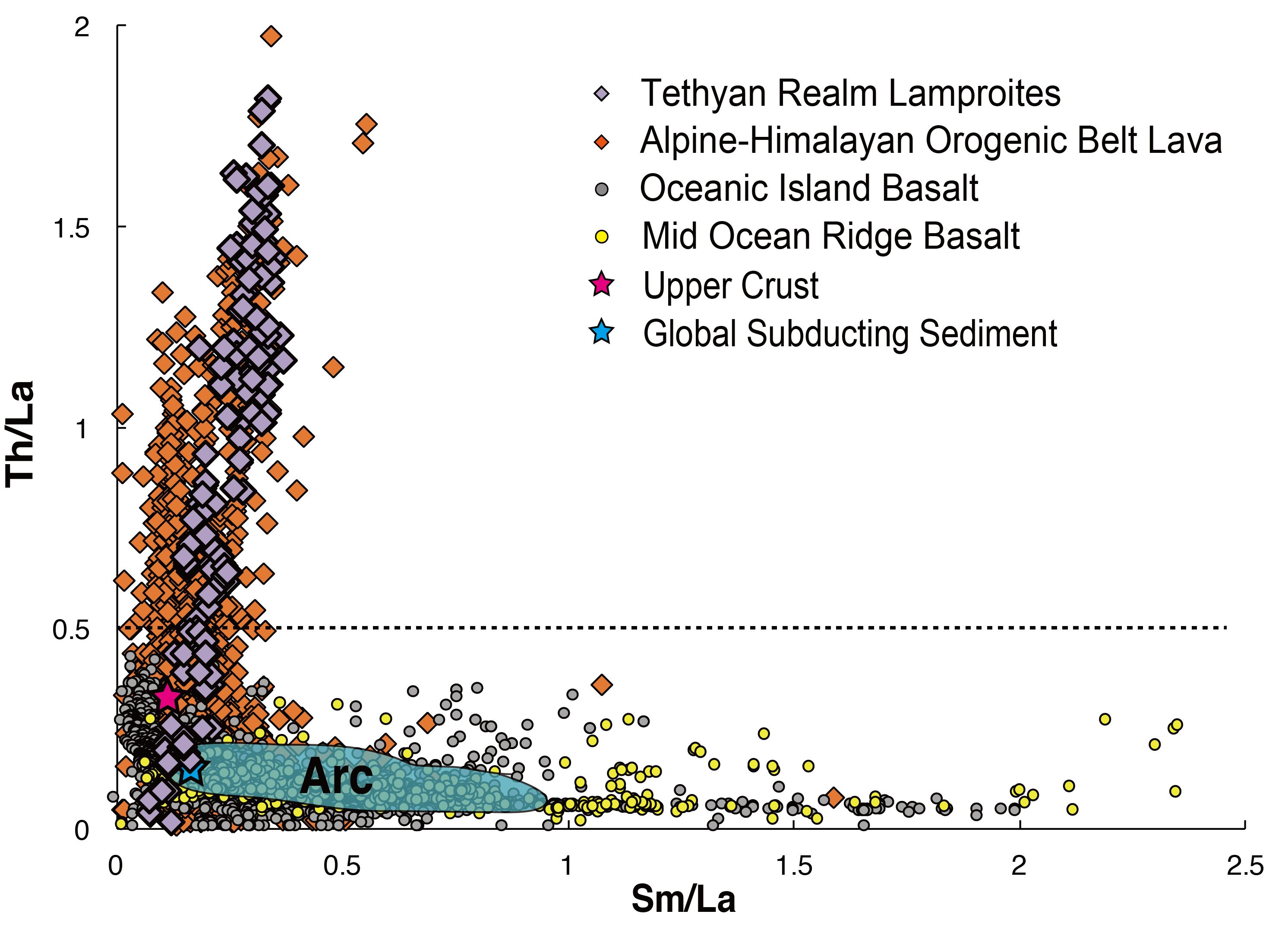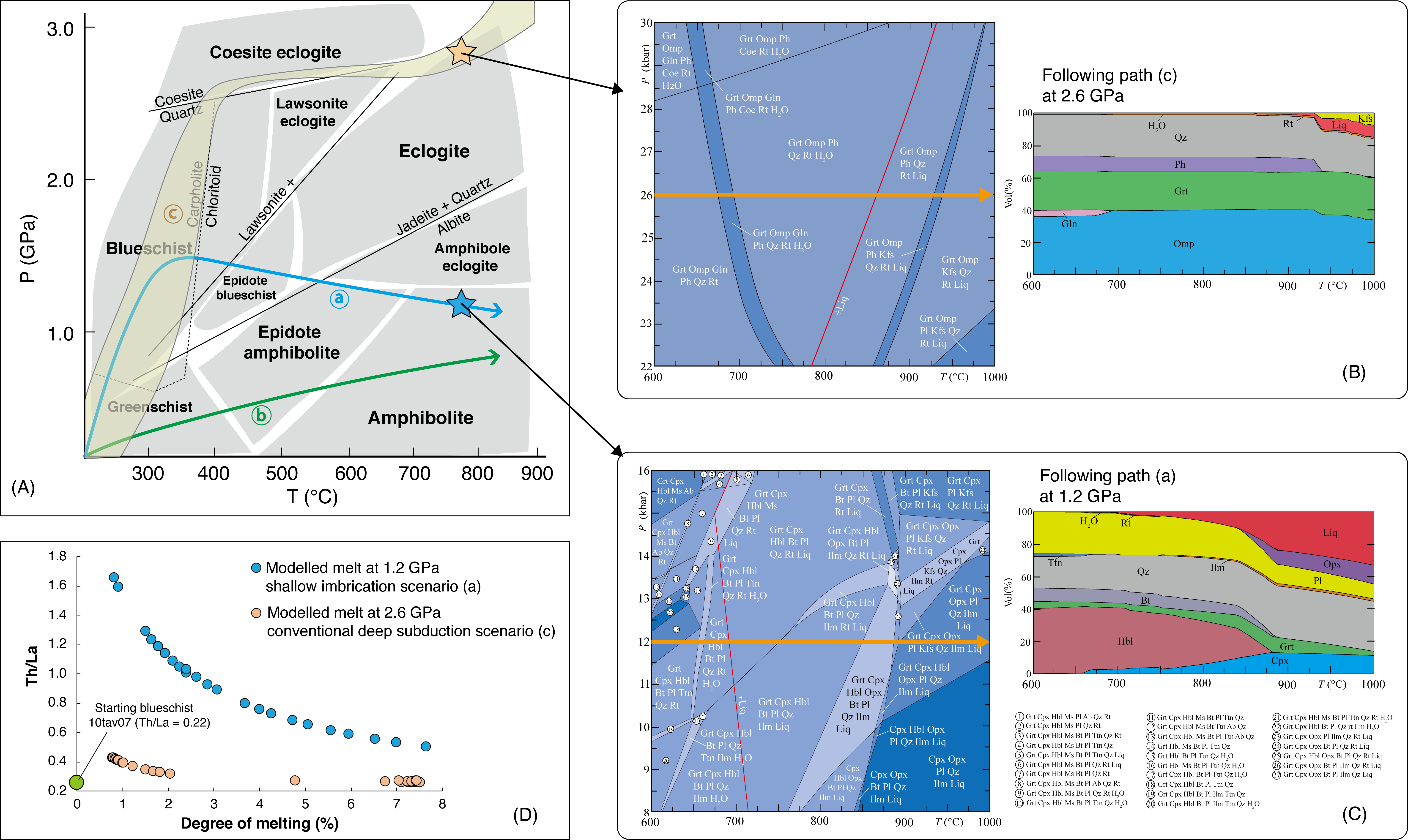Potassic volcanism commonly occurs in the late stages of orogenesis – the process of collision of plates – between a long-lasting period of subduction and the end of post-collisional collapse. The transformation of an arc system into a collisional regime is usually accompanied by volcanism that geochemically resembles the older arc lavas, and yet has important additional ingredients derived from the continental lithosphere. The syn-collisional episode evolves into a post-collisional phase during which volcanism may be extremely variable due to a combination of slab detachment, delamination, slab roll back and extension, and each of these processes may involve different sources and melting regimes. These processes are reflected in the geochemistry of the erupted orogenic magmas, which represent the end result of complex, multistage processes. Furthermore, in some regions such as Tibet, where massive continental collision occurred later, the tectonic regime in which potassic volcanism occurs may be obfuscated by later tectonic processes.
The tectonic regime that triggered widespread orogenic volcanism in the Alpine-Himalayan chain is controversial. There is now abundant evidence from trace elements and isotopes for the involvement of continental material in the source, but the style and mechanism of this crustal involvement remain unclear. Two competing scenarios invoke [1] direct melting of continental crust during deep intercontinental subduction; and [2] delamination of heavily metasomatised mantle lithosphere into the convecting mantle where melting of its most fusible parts occurs. However, direct evidence to distinguish between these two models has been lacking.
The Th/La ratio has been used to assess whether certain chemical features shared by arc magmas and continental crust are induced by subduction processes or are derived from recycled subducted sediment. In normal circumstances the Th/La ratio of mantle-derived magmas should be relatively constant and no greater than 0.5. However, post-collisional lamproites of the “Tethyan-realm”, which later developed into the Alpine-Himalayan Orogenic Belt (AHOB), were reported to have high Th/La ratios of up to 2.2. Given their exceptional enrichment in potassium and other strongly incompatible elements, lamproites have been considered the optimal probe to characterize strongly metasomatised mantle to constrain the source of the Alpine-Himalayan orogenic magmatism. The unusual geochemical signature of extremely high Th/La coupled with relatively low Sm/La is not restricted to lamproites in the Alpine-Himalayan orogenic belt, but also occurs in many other potassium-rich volcanic rocks in the same belt (Fig. 1). Two main mechanisms have been put forward to explain this anomalously high Th/La: [1] preferential uptake of La relative to Th in mafic minerals during direct melting of continental crust; and [2] melting of mélanges that include lawsonite/zoisite-bearing blueschists accreted to the colliding continental plates.

Fig. 1 Sm/La vs. Th/La in rocks with different origins. “Arc” field = magmas related to slab-derived mantle metasomatism. Values of Th/La >0.5 (dotted line) are considered anomalous and characteristic of AHOB lavas.
Researchers from Guangzhou Institute of Geochemistry, Chinese Academy of Sciences, University of Mainz, and Macquarie University published a new research article on Science Advances where they propose a comprehensive model that is a variant of the second hypothesis (Fig. 2). This model explains the source regions of the AHOB potassic volcanic rocks as consisting of blueschist facies me?langes (including oceanic crust, oceanic and continental sediments) imbricated together with extremely depleted forearc peridotites. Together these make up a mantle lithosphere that was newly formed during the convergence of small continental blocks and oceans. The imbrication process took place entirely at shallow depths (<80 km) and did not require any deep subduction of continental materials. Lawsonite blueschists provide significant new petrological and geochemical evidence to explain the Th/La fractionation widely seen in AHOB potassium-rich lavas. This mechanism is consistent with a temporal trend in Th/La in potassic post-collisional magmas: the high Th/La signature first becomes prominent in the Phanerozoic, when blueschists became widespread (Fig. 3). These processes are significant for arcs and orogenic magmatism on the modern Earth, but will be particularly pertinent to the late Archean, during which crustal formation by the amalgamation of arcs may have been widespread.

Fig. 2 Deep subduction vs. shallow imbrication. (A) Three contrasting prograde P-T-t paths for (a) shallow subduction and tectonic imbrication discussed for the Alpine-Himalayan Belt (blue line), (b) normal regional (orogenic) metamorphic scenario (green line) and (c) conventional deep Andean-style subduction [beige shaded field]. During subduction, path (a) reaches blueschist facies, and tectonic imbrication may store abundant blueschists in the lithosphere. This material is now removed from the subduction environment and is isolated from further movements. During post-collisional processes, these rocks slowly heat up (path a) and move slowly from blueschist, through epidote amphibolite to upper amphibolite facies. In contrast, path (b) follows a path from greenschist to epidote amphibolite then to amphibolite. but does not pass through the blueschist facies. (B-C) Full pressure-temperature (P-T) pseudosection diagrams for the Tavs?anl? blueschist 10tav07 at 600-1000℃, 0.8-1.6 GPa and 2.2-3.0 GPa following path a and c in (A), respectively. Also shown are calculated modal proportions for melting along apparent pressure of 1.2 GPa and 2.6 GPa. Plots of modal proportions vs. temperature (also known as modebox diagrams) illustrate the changing abundance of phases, modelled along linear pressure of 1.2 GPa and 2.6 GPa (orange lines with arrow). (D) Comparison between modelled Th/La ratios for melts produced at 1.2 GPa (shallow imbrication scenario) and melts produced at 2.6 GPa (conventional deep subduction scenario) at given degree of melting. Starting Th/La in blueschist 10tav07 is 0.22, many blueschists have higher ratios. Note the striking difference of Th/La ratios between the two types of modelled melts. Grt, garnet; omp, omphacite; gln, glaucophane; ph, phengite; coe, coesite; qz, quartz; rt, rutile; kfs, K-feldspar; pl, plagioclase; liq, melt; cpx, clinopyroxene; opx, orthopyroxene; hbl, hornblende; ttn, titanite; bt, biotite; ilm, ilmenite; ms, muscovite; ab, albite.

Fig. 3. Temporal variation in Sm/La vs. Th/La of potassium-rich orogenic volcanics through time. From <80 Ma (Alpine-Himalayan orogen), 200-400 Ma (South China, Central Asian and Variscan orogens), 410-800 Ma (Appalachian, Caledonide, Brasiliano and Pan-African orogens) to 980-1800 Ma (Grenvillian and Svecofennian orogens). Note there is a clear secular trend of increasing Th/La ratio through time where no elevated Th/La present for Grenvillian and Svecofennian times.
This work was supported by the Strategic Priority Research Program (B) of Chinese Academy of Sciences (Grant No. XDB18000000), National Natural Science Foundation of China (Grant No. 41773055), the ARC Centre of Excellence for Core to Crust Fluid Systems (CCFS), and the Youth Innovation Promotion Association of the Chinese Academy of Sciences (2020348). SF is funded by ARC grant FL180100134. JS is supported by the CAS President's International Fellowship Initiative for Postdoctoral Researchers (Grant No. 2021PC0013).
Y.Wang (王煜), S.F. Foley, S.Buhre, J.Soldner, Y.Xu (徐义刚), Origin of potassic postcollisional volcanic rocks in young, shallow, blueschist-rich lithosphere. Sci. Adv. 7, eabc0291 (2021). DOI: 10.1126/sciadv.abc0291